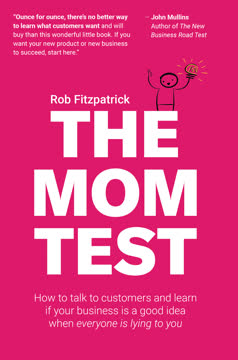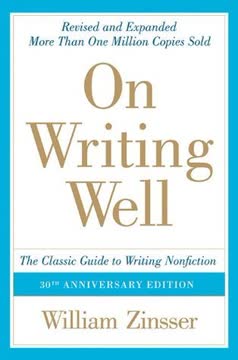重点摘要
1. 设计你的非虚构书籍以实现长期推荐性
你的书的承诺应该出现在(或至少在)标题和/或副标题中强烈暗示。
解决问题的重点: 将你的非虚构书籍设计为问题解决者而不是愉悦提供者。确定你的理想读者所面临的具体问题或目标,并围绕提供明确的解决方案或实现路径来构建你的书。这种方法使你的书对目标读者更具推荐性和价值。
明确的承诺: 确保你的书名和副标题清楚地传达其对读者的承诺。这有助于潜在读者快速了解这本书是否与他们的需求相关,并增加他们购买和推荐的可能性。考虑使用直接陈述你的书解决的问题或提供的结果的格式。
- 明确解决问题的书名示例:
- 布拉德福德·安吉尔的《如何在森林中生存》
- 罗布·菲茨帕特里克和德文·亨特的《工作坊生存指南》
- 詹姆斯·克利尔的《原子习惯》
2. 通过读者对话在写作前测试和改进你的书
倾听和教学是写作的一部分。
读者对话: 在写作手稿之前,与潜在读者进行两种类型的对话:
- 倾听/理解对话以验证和改进你的范围
- 教学/帮助对话以完善你的目录和结构
目录优化: 创建一个详细的目录,使用清晰、描述性的语言和小节来概述书的主要要点。使用这个目录作为你书的教育设计蓝图,并指导你与潜在读者的对话。
- 创建有效目录的提示:
- 使用清晰、描述性的标题为章节和小节命名
- 在每个标题中包含主要的学习成果或要点
- 添加详细的小节以提供内容的全面概述
3. 通过前置价值创造引人入胜的读者体验
至少每隔几页,你希望你的读者在想,“哇,我可以用这个。”
每页价值: 专注于在整本书中提供持续的价值。旨在每页提供有用的见解、可操作的建议或发人深省的想法,以保持读者的参与和阅读动机。
前置策略:
- 以最有影响力的内容开始,以立即吸引读者
- 重新安排你的内容,将真正有价值的部分提前插入书中
- 考虑以书的“重大揭示”或主要要点开始
为参与度编辑: 使用你的目录通过在章节标题中添加字数来可视化读者体验。这使你能够识别和解决:
- 开头缓慢
- 没有重大见解的长篇大论
- 相对于其价值字数较多的章节
4. 利用测试读者完善你的手稿
测试读者既不是付费专业人士,也不是善良的朋友。相反,他们是真正的、诚实的读者,他们非常想要你正在创造的东西,以至于愿意忍受早期、尴尬、不完善的手稿。
测试阅读过程: 在你的手稿仍有问题时尽早开始测试阅读。这使你能够在投入大量时间进行详细编辑和完善之前发现并解决重大问题。
收集反馈: 从测试读者那里寻找三种类型的见解:
- 从他们的评论中获得的定性见解
- 基于他们感到无聊或停止阅读的地方的定量见解
- 观察他们如何在生活中应用书中的想法的见解
迭代改进: 以2-8周为一轮进行测试阅读,每轮有3-5名深度参与的读者。使用他们的反馈不断改进你的手稿,直到达到以下标准:
- 招募新的测试读者变得容易(有吸引力)
- 大多数读者都能获得价值并读到结尾(有效且引人入胜)
- 一些读者带来了他们的朋友(推荐循环正在运行)
5. 实施有效的种子营销策略
发布是一年,而不是一天。
种子读者: 目标是在依赖自然增长之前将你的书送到500-1000名种子读者手中。这个初始受众将帮助推动口碑推荐并启动你的书的成功。
营销选项:
- 通过播客和在线活动进行数字书籍巡回
- 亚马逊PPC(按点击付费)广告
- 活动赠品和批量销售
- 通过内容营销建立一个小型作者平台
内容营销方法:
- 将你的手稿内容重新用作营销材料
- 分享草稿、摘录和幕后见解
- 创建一致的内容发布计划以保持责任感
- 捕获电子邮件地址以将兴趣转化为忠实受众
6. 优化你的亚马逊页面以增加销售
你的第一个挑战是吸引潜在读者点击你的封面而不是别人的。之后,你的商店页面必须说服他们你的书确实是他们当前目标或问题的最佳解决方案。
封面设计: 创建一个“可点击”的封面,使其承诺清晰,并在缩略图中易于辨认。确保你的书的承诺从封面图像中立即显现。
亚马逊商店页面优化:
- 撰写一个引人注目的书籍描述,直接针对读者的情况和目标
- 使用视觉提示(标题、列表、粗体文本)提高可浏览性
- 填写所有可用部分,包括作者简介、编辑评论和额外的产品图片
评论: 目标是获得20-40个经过验证的评论以建立社会证明。鼓励稳定的有机评论流以提高你的书在亚马逊算法中的排名。
7. 与粉丝互动并利用盗版为你所用
人们喜欢能够与作者联系,与你的粉丝互动将有助于创造超级传道者和营销/公关机会。
粉丝互动: 通过分享联系信息并回应问题或评论,使自己对读者可用。这种方法可以增加传道行为和偶然的促销机会。
利用社交媒体:
- 监控社交平台上对你书的提及
- 与讨论你作品的读者互动
- 使用读者的问题作为你作者平台的内容(例如,创建视频回应)
盗版策略: 与其打击盗版,不如利用它为你所用:
- 将你的书用作更广泛业务的潜在客户生成(例如,咨询或培训)
- 在书中包含鼓励即使是“免费”读者也与你的平台或额外产品互动的钩子
- 将盗版视为一种社会影响,可能会接触到那些买不起你书的读者
最后更新日期:
FAQ
What's "Write Useful Books" about?
- Purpose and Approach: "Write Useful Books" by Rob Fitzpatrick is a guide for authors on how to design and refine nonfiction books that are highly recommendable and long-lasting. It draws on lessons from product design and entrepreneurship.
- Focus on Usefulness: The book emphasizes creating nonfiction that is so useful that readers can't help but recommend it, leading to organic growth without heavy marketing.
- Reader-Centric Process: It advocates for involving real readers early in the writing process to test and improve the book's content and structure.
- Long-Term Growth: The goal is to create books that grow through word of mouth and remain relevant over time, entering the back catalog of enduring titles.
Why should I read "Write Useful Books"?
- Practical Guidance: The book offers a modern approach to writing nonfiction that stands out in a crowded market, focusing on creating value for readers.
- Proven Strategies: It shares strategies that have been successful for the author, Rob Fitzpatrick, whose book "The Mom Test" achieved long-term success through word of mouth.
- Reader Engagement: You'll learn how to engage with readers early and often, ensuring your book meets their needs and expectations.
- Organic Growth: The book provides insights into achieving organic growth and recommendability, reducing the need for extensive marketing efforts.
What are the key takeaways of "Write Useful Books"?
- Design for Recommendability: Focus on creating a book that readers will naturally recommend to others, ensuring long-term success.
- Involve Real Readers: Engage with potential readers early in the process to test and refine your book's content and structure.
- Focus on Value: Ensure your book delivers real, actionable value to readers, maintaining high value-per-page.
- Optimize for Longevity: Write content that remains relevant over time, avoiding trends that may quickly become outdated.
How does Rob Fitzpatrick suggest improving a book before it's written?
- Reader Conversations: Use listening and teaching conversations to understand reader needs and test your book's scope and structure.
- Escape the Curse of Knowledge: Gain empathy for your readers by understanding their perspective and challenges.
- Iterate Quickly: Use feedback from these conversations to make quick iterations on your book's design and content.
- Focus on Outcomes: Ensure your book's promise and outcomes are clear and desirable to your target audience.
What is the DEEP framework in "Write Useful Books"?
- Desirable: Ensure your book's promise is something readers want and are willing to recommend.
- Effective: The book must deliver real results and value to the average reader.
- Engaging: Create a rewarding reading experience with high value-per-page and front-loaded insights.
- Polished: Present a professionally written and well-edited book to enhance credibility and reader satisfaction.
How does "Write Useful Books" recommend using beta readers?
- Early Involvement: Start beta reading after the third draft, before professional editing, to catch big issues early.
- Iterative Process: Run multiple iterations of beta reading, using feedback to improve the manuscript progressively.
- Diverse Feedback: Gather insights from qualitative comments, engagement patterns, and how readers apply the book's ideas.
- Signal of Completion: A book is ready when beta readers find it desirable, effective, and engaging, and when they start recommending it to others.
What are the recommended seed marketing strategies in "Write Useful Books"?
- Digital Book Tour: Appear on podcasts and online events to reach a wide audience efficiently.
- Amazon PPC Ads: Use Amazon's pay-per-click advertising to reach potential readers with high purchase intent.
- Event Giveaways: Distribute books at relevant events to quickly seed your audience with ideal readers.
- Content Marketing: Build an author platform by sharing your writing process and insights publicly to attract an audience.
How does "Write Useful Books" suggest optimizing a book for sales and growth?
- Amazon Funnel Optimization: Ensure your book's cover, title, and store page are compelling and clearly convey the book's promise.
- Extra Formats and Platforms: Consider audiobooks, additional platforms, and related products to boost sales and reach.
- Engage with Fans: Maintain contact with readers to foster evangelism and leverage their networks for organic growth.
- Leverage Piracy: Use the book as a lead generation tool, turning piracy into an advantage by offering additional value.
What are some of the best quotes from "Write Useful Books" and what do they mean?
- "The goal of book marketing is to stop needing to do it." This emphasizes creating a book so useful that it grows through word of mouth, reducing the need for ongoing marketing efforts.
- "You don’t hope for recommendations; you design for them." This highlights the intentionality required in crafting a book that naturally encourages reader recommendations.
- "Better to be loved by someone than ignored by everyone." Focus on serving a specific audience deeply rather than trying to appeal to everyone, which can dilute the book's impact.
How does Rob Fitzpatrick address the challenge of pricing in "Write Useful Books"?
- Higher Pricing Justification: Useful nonfiction can be priced higher due to its value, but it should still be accessible to the target audience.
- Ebook Pricing Strategy: Keep ebooks priced at $9.99 or below on Amazon to maximize royalties, as higher prices reduce the royalty percentage.
- Upsell Opportunities: Consider offering additional resources or services as upsells to increase overall profitability.
- Balance Value and Cost: Ensure the book's price reflects its value while remaining competitive in the market.
What is the role of reader experience in "Write Useful Books"?
- Value Over Time: The book should deliver consistent value throughout, maintaining reader engagement and satisfaction.
- Front-Load Value: Deliver key insights early to hook readers and encourage them to continue reading.
- Avoid Fluff: Remove unnecessary content to increase value-per-page and keep readers engaged.
- Visualize Experience: Use a detailed table of contents with word counts to identify and address potential engagement issues.
How does "Write Useful Books" suggest handling negative feedback?
- Embrace Criticism: View negative feedback as an opportunity to improve the book before it's published.
- Separate Ego from Product: Focus on the manuscript's issues rather than taking criticism personally.
- Iterate Based on Feedback: Use feedback to make meaningful changes that enhance the book's effectiveness and engagement.
- Detect Boredom: Pay attention to where readers disengage and address those areas to improve the overall experience.
评论
《写有用的书》获得了压倒性的好评,读者们称赞其实用、简洁的非虚构写作方法。许多人欣赏书中对为读者创造价值的关注以及对写作过程的逐步指导。评论者们强调了书中对读者反馈、迭代改进和营销策略的重视。一些读者认为这本书对他们的写作方法具有变革性影响,而少数人希望书中能有更多关于写作技巧的内容。总体而言,读者们认为这是非虚构写作新手的必备资源。
Similar Books














